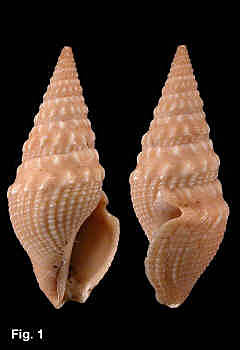|
|
|
|
Epidirona hedleyi Iredale, 1931 Description: Shell heavy with short anterior canal. Spire whorls with two spiral rows of axially elongate nodules, one below suture and other below mid-whorl, separated by broad groove; nodules slightly oblique, but upper row in opposite direction to lower row. Whorls grooved with fine spiral ribs. Body whorl below periphery bears axial and spiral ribs of about equal strength, forming nodules at their intersections. Columella and outer lip smooth. Outer lip with deep rounded V shaped sinus just above periphery. Colour uniformly light brown when alive, fading to cream or white in dead shells. Size: Up to 32 mm in length. Distribution: Endemic to Australia; Ballina to Twofold Bay, NSW. Habitat: Taken down to 137 m, but known mainly from dead beach shells. Uncommon. Comparison: This species is distinguished by being the largest of the genus, and by having a broad groove around each whorl just above mid-whorl. Synonymy: In early Australian literature this species was misidentified as Clavatula striata Gray, 1827, which is a West Australian species. Remarks: This is the largest of the turrids found in NSW, and the only large species found with any frequency on beaches around Sydney, although it is never common. Fig. 1: Broken Bay, Pittwater, NSW (C.371707) |
